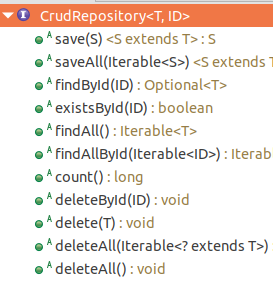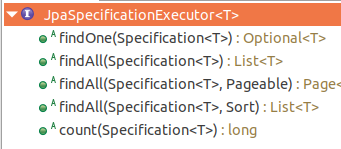您好,登錄后才能下訂單哦!
您好,登錄后才能下訂單哦!
這篇文章給大家介紹如何理解Spring Data JPA查詢方式及方法名查詢規則,內容非常詳細,感興趣的小伙伴們可以參考借鑒,希望對大家能有所幫助。
Spring Data JPA
在執行查詢時,Spring Data JPA框架會把方法名進行解析,解析到前綴比如 get、getBy、find、findBy、read、readBy時,會先把這些前綴截取掉,然后對剩下部分進行解析,剩下部分分為兩種:一是只有屬性名,二是屬性名+條件;條件很好解析,解析的關鍵在于屬性名,下面拿一個具體的例子來幫助大家更好的理解屬性名解析規則。
解析規則例子:比如實體為Product,方法為findByGoodsTypeDetail ();
1、首先截取掉 findBy,然后對剩下的屬性進行解析;
2、先判斷 goodsTypeDetail(根據 POJO 規范,首字母變為小寫,下同)是否為 Product的一個屬性,如果是,則表示根據該屬性進行查詢;如果沒有該屬性,繼續第三步;
3、從右往左截取第一個大寫字母開頭的字符串(本方法為 Detail),然后對比剩下的字符串(本方法為goodsType)是否為 Product的一個屬性,如果是,則表示根據該屬性進行查詢;如果沒有該屬性,則重復第三步,繼續從右往左截取(此處為TypeDetail,剩下goods),就這樣一直循環到最終;假設 goods為 Product的一個屬性,則說明goods不是常量類型,而是一個對象類型;
4、此時剩下字符串 TypeDetail,先判斷goods對象中是否有 typeDetail屬性,如果有,則表示該方法最終是根據 "Product.goods.typeDetail" 的值進行查詢;如果沒有該屬性,則繼續按照第三步的規則從右往左截取,最終表示根據 "Product.goods.type.detail" 的值進行查詢。
不過這種解析規則不是完美的,也存在bug,不注意可能會掉到這個坑里,比如Product中有一個屬性叫goods,同時還有一個屬性叫goodsType,這時在解析時會出現混亂,不過可以在屬性之間加上 "_"來解決這個問題,注意:"_"是加在查詢方法上的,不是加在屬性名上的;比如 "findByGoods_TypeDetail()" (當Product中不存在goods_TypeDetail時,是給解析器說明Goods為一個對象)或"findByGoodsType_Detail()"(當Product中不存在goodsType_Detail時,是給解析器說明GoodsType為一個對象)。
查詢時,很多時候需要同時使用多個屬性進行查詢,而且查詢的條件也各不相同,Spring Data JPA 為此提供了一些條件查詢的關鍵字,我把常用的都整理了一下,如下表:
關鍵字 | 對應SQL關鍵字 | 示例 |
列名 | 根據列名查詢 | findByName(String name);自動解析findBy后面的列名,然后根據列名查詢。 |
In | 等價于SQL 中的 in | findByNameIn(Collection<String> nameList) ;參數可以是集合、數組、不定長參數; |
Like | 等價于SQL 中的 like | findByNameLike(String name); |
| NotLike | 等價于SQL 中的 not like | findByNameNotLike(String name); |
And | 等價于SQL 中的 and | findByNameAndPwd(String name, String pwd); |
Or | 等價于SQL 中的 or | findByIdOrCode(String id, String code); |
Between | 等價于SQL 中的 between | findByNumBetween(int max, int min); |
OrderBy | 等價于SQL 中的 order by | findByNameOrderByNumAsc(String name); |
IsNull | 等價于SQL 中的 is null | findByNameIsNull(); |
| IsNotNull | 等價于SQL 中的 is not null | findByNameIsNotNull(); |
| NotNull | 等價于SQL 中的 is not null | findByNameNotNull();--和IsNotNull 一樣,建議使用IsNotNull |
| Not | 等價于SQL 中的 ! = | findByNameNot(String name); |
| NotIn | 等價于SQL 中的 not in | findByNameNotIn(Collection<String> nameList) ;參數可以是集合、數組、不定長參數; |
| LessThan | 等價于SQL 中的 < | findByNumLessThan(int num); |
GreaterThan | 等價于SQL 中的 > | findByNumGreaterThan(int num); |
1、使用 @Query 提供的位置編號查詢:格式為":位置編號",然后方法中的參數按 JPQL 查詢語句的位置編號順序書寫。 如下:
public interface ProductDao extends Repository<Product , Long> {
@Query("select * from Product p where p.id= ?1")
public Product findById(Long id);
@Query("select * from Product p where p.type = ?1 and p.name =?2")
public Page<Product> findByTypeAndName(
Integer type,String name,Pageable pageable);
}2、使用@Query 命名參數查詢:格式為": 變量",同時在方法的參數前面使用 @Param 將方法參數與JPQL中的命名參數對應。如下:
public interface ProductDao extends Repository<Product , Long> {
@Query("from Product p where p.goodsName= :name")
public Product findByGoodsName(@Param("name")String name);
@Query("from Product p where p.num < :num")
public Page<Product> findByNumLessThan(
@Param("num")Integer num,Pageable pageable);
}3、 使用 @Modifying 將查詢操作標識為更新操作:在使用 @Query 的同時使用 @Modifying ,這樣會生成一個更新的操作,而非查詢。如下:
@Query("update Product p set p.name = ?1 where p.id = ?2")
@Modifying
public int updateName(String name, int id);以這張表為例:
+-------------+--------------+------+-----+-------------------+----------------+ | Field | Type | Null | Key | Default | Extra | +-------------+--------------+------+-----+-------------------+----------------+ | id | int(11) | NO | PRI | NULL | auto_increment | | role | varchar(45) | NO | | NULL | | | permissions | varchar(512) | NO | | NULL | | | create_time | datetime | NO | | CURRENT_TIMESTAMP | | | status | varchar(45) | NO | | NULL | | | role_name | varchar(45) | NO | | NULL | | +-------------+--------------+------+-----+-------------------+----------------+

@Repository
public interface RoleRepository extends CrudRepository<RoleData, Integer> {
}
@Entity
@Table(name = "role", catalog = "message_push")
public class RoleData implements java.io.Serializable {
@Id
@GeneratedValue
private Integer id;
private String role;
private String permissions;
private Long create_time;
private Integer status;
// getter setter 構造函數從略
}list<RoleData> findByXXX(xxx) 其中 XXX 對應數據庫中的字段,例如:
@Repository
public interface RoleRepository extends CrudRepository<RoleData, Integer> {
List<RoleData> findByRole(String role);
List<RoleData> findByStatus(String status);
}還可以多字段AND 查詢:
@Repository
public interface RoleRepository extends CrudRepository<RoleData, Integer> {
List<RoleData> findByRoleAndStatus(String role, String status);
}在 application.properties 中加入以下配置 spring.jpa.show-sql=true 可以看到SQL語句:
Hibernate: select roledata0_.id as id1_0_, roledata0_.create_time as create_t2_0_, roledata0_.permissions as permissi3_0_, roledata0_.role as role4_0_, roledata0_.status as status5_0_ from message_push.role roledata0_ where roledata0_.role=? and roledata0_.status=?
當然 or 也是可以:
List<RoleData> findByRoleOrStatus(String role, String status);
Hibernate: select roledata0_.id as id1_0_, roledata0_.create_time as create_t2_0_, roledata0_.permissions as permissi3_0_, roledata0_.role as role4_0_, roledata0_.status as status5_0_ from message_push.role roledata0_ where roledata0_.role=? or roledata0_.status=?
例如:
@Query(value = "select * from role where role = ?1", nativeQuery = true) List<RoleData> searchByRole(String role);
或 sql in 用法
@Query(value = "select * from role where role in (?1) and status = 'valid'", nativeQuery = true) List<RoleData> searchByRoleList(List<String> targetList);
又或 sql like 用法:
@Query(value = "select * from role where role like %?1%", nativeQuery = true) List<RoleData> searchByRole(String keyWord);
先來看一下 JpaSpecificationExecutor 接口

以 findAll(Specification<T>) 為例進行說明:
Specification<T> 可以理解為一個查詢條件。findAll 以這個條件為基準進行查詢,也就是我們在sql 里寫的 whre xxx 轉為 Specification 來寫。
首先要讓我們的 repository 繼承 JpaSpecificationExecutor
@Repository
public interface RoleRepository extends CrudRepository<RoleData, Integer>, JpaSpecificationExecutor<RoleData> {接下來,將這個查詢 [ select * from role where role like '%a%' ] 轉為一個簡單的 Specification。
final Specification<RoleData> spec = new Specification<RoleData> () {
@Override
public Predicate toPredicate(Root<RoleData> root, CriteriaQuery<?> query, CriteriaBuilder criteriaBuilder) {
Predicate predicate = criteriaBuilder.like(root.get("role"), "%a%");
return predicate;
}
};然后直接按如下方式調用即可:
roleRepository.findAll(spec);
Specification 里又衍生出了好幾個類,分別介紹一下:
因為我們實現 Specification 接口時,只需要實現 Predicate toPredicate() 方法。而 Specification 上文中我們當做搜索條件來理解了,那么也可以簡單的把 Predicate 視為搜索條件。
用于構建搜索條件 Predicater 的。
回想一下SQL搜索條件怎么寫
where attribute = xx where attribute > xx where attribute < xx where attribute like %xx%
注意這里有三要素:
attribute 搜索指定的數據庫字段
操作符 大于 小于 等于
具體數據
CriteriaBuilder提供了一系列靜態方法構建這三要素。
比如
CriteriaBuilder.like(數據庫字段, 具體數據)
CriteriaBuilder.equal(數據庫字段, 具體數據)
其中 數據庫字段 不能直接寫字符串,需要下一個工具類 Root 的 get 方法獲取。
root.get( String attributeName ) 參數 attributeName 就是數據庫里的字段名
現在相信讀者可以理解 我們剛才寫的 那個完整的 Specification了。
再下來再上一個稍微復雜點的例子:
[ select * from role where role like '%a%' and (id > 11 or id < 8) ]
final Specification<RoleData> spec = new Specification<RoleData> () {
@Override
public Predicate toPredicate(Root<RoleData> root, CriteriaQuery<?> query, CriteriaBuilder criteriaBuilder) {
Predicate roleLikeaPredicate = criteriaBuilder.like(root.get("role"), "%a%");
Predicate idLessThan8Predicate = criteriaBuilder.lessThan(root.get("id"), 8);
Predicate idGreaterThan12Predicate = criteriaBuilder.greaterThan(root.get("id"), 11);
Predicate idCombindedPredicate = criteriaBuilder.or(idLessThan8Predicate, idGreaterThan12Predicate);
Predicate predicate = criteriaBuilder.and(idCombindedPredicate, roleLikeaPredicate);
return predicate;
}
};其實也很簡單,就是多了 criteriaBuilder.or criteriaBuilder.and 來把多個 Predicate 合成一個新的 Predicate
最后一個例子:
可以通過root.get(xx).in(List<> list) 也是可以直接返回 Predicate 的
final Specification<RoleData> spec2 = new Specification<RoleData> () {
@Override
public Predicate toPredicate(Root<RoleData> root, CriteriaQuery<?> query, CriteriaBuilder criteriaBuilder) {
List<String> alist = new ArrayList<String>();
alist.add("admin");
Predicate predicate = root.get("role").in(alist);
return predicate;
}
};關于如何理解Spring Data JPA查詢方式及方法名查詢規則就分享到這里了,希望以上內容可以對大家有一定的幫助,可以學到更多知識。如果覺得文章不錯,可以把它分享出去讓更多的人看到。
免責聲明:本站發布的內容(圖片、視頻和文字)以原創、轉載和分享為主,文章觀點不代表本網站立場,如果涉及侵權請聯系站長郵箱:is@yisu.com進行舉報,并提供相關證據,一經查實,將立刻刪除涉嫌侵權內容。